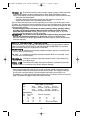
11
Tip of the Sanding Base (figure G)
• When the sanding base tip is worn, it can be
reversed or replaced.
• Reverse or replace the worn part.
Finger Attachment (figure H)
The finger attachment is used for fine detail
sanding.
• Remove the screw.
• Remove the diamond-shaped tip holder from the
sanding base.
• Fit the finger attachment onto the sanding base.
• Fit and tighten the screw.
• Align the sanding sheet with the finger attachment.
Dust Collection / Vacuum Port Adaptor
(figure I)
A vacuum hose can be attached to the sander to
allow for dust collection.
Fire hazard. Collected sanding dust from sanding surface coatings
(polyurethane, linseed oil, etc.) can self-ignite in sander dust canister or elsewhere and
cause fire. To reduce risk, empty canister frequently and strictly follow sander manual and
coating manufacturer's instructions.
Fire hazard. When working on metal surfaces, do not use a vacuum cleaner
because sparks are generated. Wear safety glasses and a dustmask. Due to the danger
of fire, do not use your sander to sand magnesium surfaces. Do not use for wet sanding.
Hints for optimum use
• Do not place your hands over the ventilation slots.
• Do not exert too much pressure on the tool.
• Regularly check the condition of the sanding sheet. Replace when necessary.
• Always sand with the grain of the wood.
• When sanding new layers of paint before applying another layer, use extra fine grit.
• On very uneven surfaces, or when removing layers of paint, start with a coarse grit.
On other surfaces, start with a medium grit. In both cases, gradually change to a fine
grit for a smooth finish.
:
:
G
H
I
90550099 PC1800DS Crdl Sander REVISED 4/1/09 1:52 PM Page 11


















